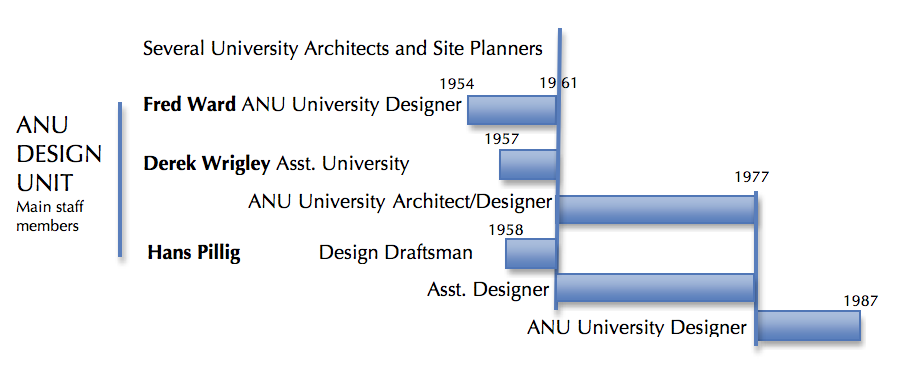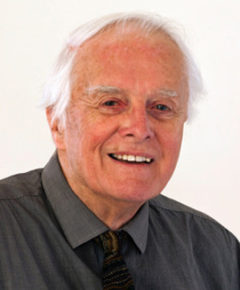ANU DESIGN UNIT 1954-87
A retrospective view of the ANUDU

This is a story of a unique creative unit within the administrative area of the Australian National University which contributed aesthetically, physically and philosophically to the practical development of the ANU campus in the heart of Canberra in the Australian Capital Territory.
While it is common for universities all over the world to have a position similar to University Architect I have never been able to find any other university with a specific Design Unit.
Its formation within the ANU around 1954 should be seen as a historic ‘first’ for the design profession in Australia in that the ANU recognised ‘Design’ as an additional professional entity from ‘Architecture’, thus giving some credence to the emergence of the Design profession in Australia after WW2. It should be noted here that the design profession really became recognised as a profession around 1952 by the formation of the Society of Designers for Industry (SDI – initiated in Melbourne by Fred Ward) and in Sydney (initiated in 1953 by Derek Wrigley).
To backtrack a little, Fred Ward had been asked to design furniture and equipment for University House around 1949 and the building opened in 1954. ANU was growing rapidly at that time and Ward was asked by the Vice Chancellor Sir Leslie Melville to stay on in Canberra to form what became known as the ANU Design Unit in order to establish well designed furnishings for the envisaged building program.
Ward (in Canberra) and Wrigley (in Sydney) became known to each other through their separate promotions from the SDI in 1956 of an Australian Design Council to Dr H.C. Coombs, Governor of the Reserve Bank and also a leading proponent of the formation of ANU in 1946.
Ward invited Wrigley to join him at ANU as Assistant University Designer which took place in January 1957.
Our joint emphasis at that early stage in the development of the ANU was essentially to furnish the teaching buildings of the School of General Studies within the ANU. Fred however, was tempted by Coombs in 1961 to design all the furnishings for the Reserve Bank in Sydney and resigned from ANU.
I was subsequently invited to take on a new position as ANU University Architect/Designer which gave me more scope to engage in the total design area of campus development.
I had become convinced that in an institution such as ANU the scope for good design extended to all creative endeavours on campus and that its fulfilment had a much greater role to play in supporting the aims and objectives of teaching and research. Fred imbued me with the belief that the environment for study inside the buildings could create an ambience of good design which would be subconsciously absorbed through student activities.
The original brief of the ANU itself was encapsulated in the motto on the ANU Arms “First to learn the nature of things”. This fitted well with my vision of the role of design in ANU. This included campus planning (in association with the consultant Site Planner), architecture, interiors and furnishings, landscape design, site graphics, graphic design, art collection and siting, exhibitions and miscellaneous items such as student prizes & farewell presentation gifts.
Needless to say we attracted several well-skilled specialists to join the ANUDU to enlarge our skill base – Charles Bastable and Gerald Easden (furniture), David Walker and Adrian Young (graphics), John Stevens, Pertti Tukkianen, Roger Mann (landscape)
This developed well from 1961 as a central design service until about the early 1970s when Business Managers were introduced into the Faculties and Schools with a degree of financial and organisational autonomy from centralism as practiced by two administrators in particular to whom I was responsible – Ross Hohnen, Registrar (later Secretary) and William Hamilton, Bursar, both of whom were very supportive of what we were trying to do in the Design Unit. Regrettably both were due to retire in the mid-70’s and our support base was lost.
At roughly the same time a Registrar (Property and Plans) was inserted into the Administration to whom I was then made responsible. Neither of the two subsequently appointed was qualified in any way for such a role and neither really understood the philosophical background of the Design Unit, one being an accountant, the other a historian. Money became the main determinant rather than value and quality over time.
In any case, the university building proram began to decline in the 1970s and although the University Engineer and I were interested in the advantages of solar utilisation the industry was in its infancy and we could not interest the Registrar (P+P) in what we saw as solar research relevant to the functional efficiency of our buildings.
ANU had a policy of housing new staff which included new houses, so I designed a prototype solar house in 1973 (see entry in Architecture) with the blessing of the ANU Housing Officer, but the need was not understood and funds were not forthcoming.
Administrative disinterest in what I felt was legitimate forward design thinking for such a vital organisation made my role difficult, so I resigned in 1977.
It is significant that no further University Architect has ever been appointed and infill campus development with uncontrolled architectural character has resulted and readily perceived as a great loss of visual cohesion befitting a thinking organisation.
There has been a huge vacuum in our educational system which does not recognise the functional arts and consequently we have educated administrative staff who are blind to this
I have written many times on this topic (see my early writings under design education) but the education authorities continue to believe that design thinking is included in the Art syllabus or in Design and Technology – but where are the teachers who are educated about design and its problem solving nature ? There has been no recognition of the need, but there are some small signs that the message is getting through.

